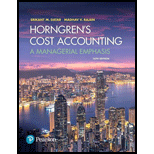
Alternative methods of joint-cost allocation, product-mix decisions. The Chicago Oil Company buys crude vegetable oil. Refining this oil results in four products at the splitoff point: A, B, C, and D. Product C is fully processed by the splitoff point. Products A, B, and D can individually be further refined into Super A, Super B, and Super D. In the most recent month (November), the output at the splitoff point was as follows:
- Product A, 550,000 gallons
- Product B, 200,000 gallons
- Product C, 150,000 gallons
- Product D, 100,000 gallons
The joint costs of purchasing and processing the crude vegetable oil were $210,000. Chicago had no beginning or ending inventories. Sales of product C in November were $90,000. Products A, B, and D were further refined and then sold. Data related to November are as follows:
| Separable |
Revenues | |
| Super A | $480,000 | $750,000 |
| Super B | 120,000 | 300,000 |
| Super D | 90,000 | 150,000 |
Chicago had the option of selling products A, B, and D at the splitoff point. This alternative would have yielded the following revenues for the November production:
- Product A, $150,000
- Product B, $125,000
- Product D, $135,000
-
- 1. Compute the gross-margin percentage for each product sold in November, using the following methods for allocating the $210,000 joint costs:
Required
- a. Sales value at splitoff
- b. Physical measure
- c. NRV
- 2. Could Chicago Oil have increased its November operating income by making different decisions about the further processing of products A, B, or D? Show the effect on operating income of any changes you recommend
Want to see the full answer?
Check out a sample textbook solution
Chapter 16 Solutions
Horngren's Cost Accounting: A Managerial Emphasis (16th Edition)
 Managerial Accounting: The Cornerstone of Busines...AccountingISBN:9781337115773Author:Maryanne M. Mowen, Don R. Hansen, Dan L. HeitgerPublisher:Cengage Learning
Managerial Accounting: The Cornerstone of Busines...AccountingISBN:9781337115773Author:Maryanne M. Mowen, Don R. Hansen, Dan L. HeitgerPublisher:Cengage Learning Cornerstones of Cost Management (Cornerstones Ser...AccountingISBN:9781305970663Author:Don R. Hansen, Maryanne M. MowenPublisher:Cengage Learning
Cornerstones of Cost Management (Cornerstones Ser...AccountingISBN:9781305970663Author:Don R. Hansen, Maryanne M. MowenPublisher:Cengage Learning Essentials of Business Analytics (MindTap Course ...StatisticsISBN:9781305627734Author:Jeffrey D. Camm, James J. Cochran, Michael J. Fry, Jeffrey W. Ohlmann, David R. AndersonPublisher:Cengage Learning
Essentials of Business Analytics (MindTap Course ...StatisticsISBN:9781305627734Author:Jeffrey D. Camm, James J. Cochran, Michael J. Fry, Jeffrey W. Ohlmann, David R. AndersonPublisher:Cengage Learning Managerial AccountingAccountingISBN:9781337912020Author:Carl Warren, Ph.d. Cma William B. TaylerPublisher:South-Western College Pub
Managerial AccountingAccountingISBN:9781337912020Author:Carl Warren, Ph.d. Cma William B. TaylerPublisher:South-Western College Pub Principles of Cost AccountingAccountingISBN:9781305087408Author:Edward J. Vanderbeck, Maria R. MitchellPublisher:Cengage LearningPrinciples of Accounting Volume 2AccountingISBN:9781947172609Author:OpenStaxPublisher:OpenStax College
Principles of Cost AccountingAccountingISBN:9781305087408Author:Edward J. Vanderbeck, Maria R. MitchellPublisher:Cengage LearningPrinciples of Accounting Volume 2AccountingISBN:9781947172609Author:OpenStaxPublisher:OpenStax College





